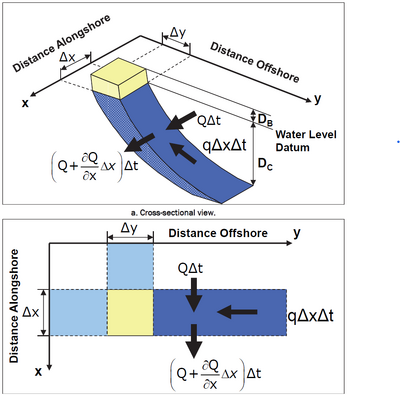GenCade:Basic Governing Equations: Difference between revisions
mNo edit summary |
mNo edit summary |
||
| Line 4: | Line 4: | ||
The resulting change in volume along the four sides of the area is therefore calculated as: | The resulting change in volume along the four sides of the area is therefore calculated as: | ||
'''ΔV = ΔxΔy(D<sub>B</sub>+D<sub>C</sub>)''' | <!--'''ΔV = ΔxΔy(D<sub>B</sub>+D<sub>C</sub>)'''--> | ||
<math>\Delta V = \Delta x \Delta y (D_B + D_C)</math> | |||
A definition sketch is shown in Figure 1. | A definition sketch is shown in Figure 1. | ||
| Line 10: | Line 11: | ||
If there is a difference between the net amount longshore sediment transport (Q, in m<sup>3</sup>/second), the volume changes. The contribution from a line source or sink is included as the term q, where q is the sum of the addition or removal of sand per unit width of beach from either the shoreward or offshore sides. Thus: | If there is a difference between the net amount longshore sediment transport (Q, in m<sup>3</sup>/second), the volume changes. The contribution from a line source or sink is included as the term q, where q is the sum of the addition or removal of sand per unit width of beach from either the shoreward or offshore sides. Thus: | ||
'''ΔV = ΔxΔy(D<sub>B</sub>+D<sub>C</sub>) = (ΔQ/Δx)ΔxΔt +qΔxΔt''' | <!--'''ΔV = ΔxΔy(D<sub>B</sub>+D<sub>C</sub>) = (ΔQ/Δx)ΔxΔt +qΔxΔt'''--> | ||
<math>\Delta V = \Delta x \Delta y (D_B + D_C) = \left(\frac{\Delta Q}{\Delta x}\right)\Delta x \Delta t + q\Delta x \Delta t</math> | |||
As Δt goes to zero, a differential equation is produced that is the governing equation for the rate of change of the shoreline position: | As Δt goes to zero, a differential equation is produced that is the governing equation for the rate of change of the shoreline position: | ||
< | <!--'''δy/δt + (1/(D<sub>B</sub>+D<sub>C</sub>)) * (δQ/δx - q) = 0'''--> | ||
<math>\frac{\delta y}{\delta t} + \frac{1}{(D_B + D_C)}\left(\frac{\delta Q}{\delta x}-q\right) = 0</math> | |||
This equation is solved with the inputs of boundary conditions and values for Q, q, DB and DC given. | This equation is solved with the inputs of boundary conditions and values for Q, q, DB and DC given. | ||
Revision as of 21:23, 20 December 2022

The governing equation of GenCade is primarily formed by conversion of sand volume. The assumption that the beach profile translates seaward or shoreward along a section of coast without changing shape. During an interval of time (Δt), a net amount of sand enters or leaves the section. The change in shoreline position is Δy, the length of the shoreline segment is Δx, and the profile moves within a vertical extent defined by the berm elevation DB and the closure depth DC, both measured from the vertical datum (for example, MSL or MLLW).
The resulting change in volume along the four sides of the area is therefore calculated as:
A definition sketch is shown in Figure 1.
If there is a difference between the net amount longshore sediment transport (Q, in m3/second), the volume changes. The contribution from a line source or sink is included as the term q, where q is the sum of the addition or removal of sand per unit width of beach from either the shoreward or offshore sides. Thus:
As Δt goes to zero, a differential equation is produced that is the governing equation for the rate of change of the shoreline position:
This equation is solved with the inputs of boundary conditions and values for Q, q, DB and DC given.
GenCade Home Page